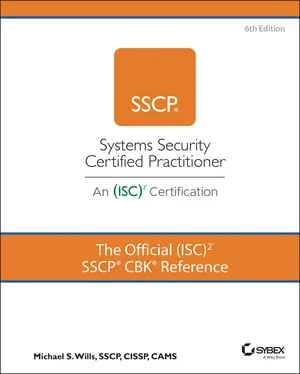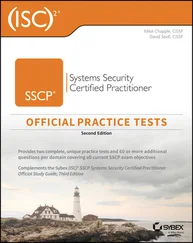Mike Wills - The Official (ISC)2 SSCP CBK Reference
Здесь есть возможность читать онлайн «Mike Wills - The Official (ISC)2 SSCP CBK Reference» — ознакомительный отрывок электронной книги совершенно бесплатно, а после прочтения отрывка купить полную версию. В некоторых случаях можно слушать аудио, скачать через торрент в формате fb2 и присутствует краткое содержание. Жанр: unrecognised, на английском языке. Описание произведения, (предисловие) а так же отзывы посетителей доступны на портале библиотеки ЛибКат.
- Название:The Official (ISC)2 SSCP CBK Reference
- Автор:
- Жанр:
- Год:неизвестен
- ISBN:нет данных
- Рейтинг книги:4 / 5. Голосов: 1
-
Избранное:Добавить в избранное
- Отзывы:
-
Ваша оценка:
- 80
- 1
- 2
- 3
- 4
- 5
The Official (ISC)2 SSCP CBK Reference: краткое содержание, описание и аннотация
Предлагаем к чтению аннотацию, описание, краткое содержание или предисловие (зависит от того, что написал сам автор книги «The Official (ISC)2 SSCP CBK Reference»). Если вы не нашли необходимую информацию о книге — напишите в комментариях, мы постараемся отыскать её.
The Official (ISC)2 SSCP CBK Reference
SSCP Study Guide
The Official (ISC)2 SSCP CBK Reference
The Official (ISC)2 SSCP CBK Reference — читать онлайн ознакомительный отрывок
Ниже представлен текст книги, разбитый по страницам. Система сохранения места последней прочитанной страницы, позволяет с удобством читать онлайн бесплатно книгу «The Official (ISC)2 SSCP CBK Reference», без необходимости каждый раз заново искать на чём Вы остановились. Поставьте закладку, и сможете в любой момент перейти на страницу, на которой закончили чтение.
Интервал:
Закладка:
LDAP can also be used to authenticate user credentials by an LDAP command called bind . In the simplest case, bind checks the entered candidate password against the userPassword attribute (receiving either a success code or the error Invalid credentials).
Microsoft's ubiquitous Active Directory (AD), developed for Windows domain networks, uses LDAP versions 2 and 3. Active Directory is a proprietary directory service, which is part of the Windows Server technology base; while this means it must be deployed on a Windows Server platform, AD can support networks with virtually any mix of device types and operating systems. A server running Active Directory Domain Services (AD DS), called a domain controller, authenticates users and authorizes actions, verifying their credentials and defining their access rights. Active Directory Domain Services provide structured hierarchical data storage for users, printers, and services, as well as support for locating and working with those objects.
On a larger, multinetwork or multi-enterprise playing field, Active Directory Federation Services (AD FS) can allow the sharing of information between trusted business partners. AD FS can provide single sign-on to federated partners just as other federated identity management systems can.
Two more modern protocols are commonly used together to provide authentication services. OAuth 2.0 and OpenID Connect offer a related but competing approach to SAML.
OpenID Connect is an implementation of the authorization framework OAuth 2.0, facilitating the communication of attribute and authentication information. Whereas SAML specifically relays requests from a website, OpenID Connect can work to effect authentication with either a website or mobile application as the requester.
An OpenID Connect (OIDC) authentication sequence requires the selection of an OpenID identify provider. Once the IdP is known, OIDC operates as an authentication layer on top of the OAuth 2.0 protocol, allowing the relying party to request and receive information about the user from the IdP.
OAuth 2.0 is itself an authorization protocol. Using it, a client application can request access to a protected resource from the entity that owns that resource. The request goes to an authorization server, which must authenticate the resource owner, validate the request, obtain authorization from the resource owner, and then relay an authorization token to the resource server that hosts the protected resource.
In the OIDC authentication implementation, the relying party (RP) is an OAuth 2.0 application requesting an ID token from an OpenID Connect Provider (OP). The fields in the token will contain data (“claims”) about both the user (called the subject, or sub, and known by a locally unique identifier) and the timing (both the “issued at” time, or iat, and the expiration time, exp) of the authentication event. Also, the ID token will contain the issuer identifier (iss) of the OP and the client identifier (audience, or aud) registered for the RP at the issuer. Additionally, the claims can contain more information about the user, such as first_name, last_name, and so on. One way to view this extension of OAuth 2.0 is that OpenID Connect effectively allows an application to request authorization to authenticate a user.
IMPLEMENT ACCESS CONTROLS
Two more major decisions need to be made before you can effectively design and implement an integrated access control strategy. Each reflects in many ways the decision-making and risk tolerance culture of your organization, while coping with the physical realities of its information infrastructures. The first choice is whether to implement a centralized or decentralized access control system.
Centralized access control is implemented using one system to provide all identity management and access control mechanisms across the organization. This system is the one-stop-shopping point for all access control decisions; every request from every subject, throughout the organization, comes to this central system for authentication, authorization, and accounting. Whether this system is a cloud-hosted service or operates using a single local server or a set of servers is not the issue; the organization's logical space of subjects and objects is not partitioned or segmented (even if the organization has many LAN segments, uses VPNs, or is geographically spread about the globe) for access control decision-making. In many respects, implementing centralized access control systems can be more complex, but use of systems such as Kerberos, RADIUS, TACACS, or Active Directory can make the effort less painful. Centralized access control can provide greater payoffs for large organizations, particularly ones with complex and dispersed IT infrastructures. For example, updating the access control database to reflect changes (temporary or permanent) in user privileges is done once and pushed out by the centralized system to all affected systems elements.
Decentralized access control segments the organization's total set of subjects and objects (its access control problem) into partitions, with an access control system and its servers for each such partition. Partitioning of the access control space may reflect geographic, mission, product or market, or other characteristics of the organization and its systems. The individual access control systems (one per partition) have to coordinate with each other to ensure that changes are replicated globally across the organization. Windows Workgroups are examples of decentralized access control systems, in which each individual computer (as a member of the workgroup) makes its own access control decisions, based on its own local policy settings. Decentralized access control is often seen in applications or platforms built around database engines, in which the application, platform, or database uses its own access control logic and database for authentication, authorization, and accounting. Allowing each workgroup, platform, or application to bring its own access control mechanisms to the party, so to speak, can be simple to implement and simple to add each new platform or application to the organization's IT architecture; but over time, the maintenance and update of all of those disparate access control databases can become a nightmare.
Mandatory vs. Discretionary Access Control
The next major choice that needs to be made reflects whether the organization is delegating the fine-grained, file-by-file access control and security policy implementation details to individual users or local managers or is retaining (or enforcing) more global policy decisions with its access control implementation.
Mandatory access control (MAC) denies individual users (subjects) the capability to determine the security characteristics of files, applications, folders, or other objects within their IT workspaces. Users cannot make arbitrary decisions, for example, to share a folder tree if that sharing privilege has not been previously granted to them. This implements the mandatory security policies as defined previously and results in highly secure systems.
Discretionary access control (DAC) allows individual users to determine the security characteristics of objects, such as files, folders, or even entire systems, within their IT workspaces. This is perhaps the most common access control implementation methodology, as it comes built in to nearly every modern operating system available for servers and endpoint devices. Typically, these systems provide users with the ability to grant or deny the privileges to read, write (or create), modify, read and execute, list contents of a folder, share, extend, view other metadata associated with the object, and modify other such metadata.
The choices of centralized versus decentralized architectures, and whether to use mandatory, discretionary, or nondiscretionary access control as a global policy are important decisions that must be made before you can start implementing your IAM project. You've also got to make another set of decisions regarding the specific roles, tasks, or responsibilities that individual users or groups of users must fulfill, and correlate that with your organization's information classification guide. Combining those two sets of information informs your choice of access control models: Do your security needs dictate a role-based access control, for example, or can you safely operate with something simpler such as subject-based or object-based control? And with that decision in hand, you can then start putting AAA servers in place, configuring their services, and loading up their control information. Now , you can start provisioning user accounts.
Читать дальшеИнтервал:
Закладка:
Похожие книги на «The Official (ISC)2 SSCP CBK Reference»
Представляем Вашему вниманию похожие книги на «The Official (ISC)2 SSCP CBK Reference» списком для выбора. Мы отобрали схожую по названию и смыслу литературу в надежде предоставить читателям больше вариантов отыскать новые, интересные, ещё непрочитанные произведения.
Обсуждение, отзывы о книге «The Official (ISC)2 SSCP CBK Reference» и просто собственные мнения читателей. Оставьте ваши комментарии, напишите, что Вы думаете о произведении, его смысле или главных героях. Укажите что конкретно понравилось, а что нет, и почему Вы так считаете.












